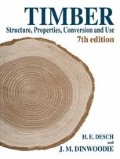Abstract
The strength of a material such as wood refers to its ability to resist applied forces that could lead to its failure, while its elasticity determines the amount of deformation that would occur under the same applied forces. These forces may be applied slowly at constant rate whereby we refer to the inherent resistance of the material as its static strength, or they may be applied exceptionally quickly, when we refer to the resistance of the material as its dynamic strength.
Preview
Unable to display preview. Download preview PDF.
References
Abbott A.R., Dinwoodie J.M, Enjily V. and Page A.V. (1992) Use of structural (C5) grade chipboard. Joint BRE/TRADA report: TRAD A Design Aid DA9.
Bodig J. and Jayne B.A. (1982) Mechanics of Wood and Wood Composites. Van Nostrand Reinhold, Wokingham, UK.
BS 373: 1957 (1986) Methods of testing small clear specimens of timber. BSI, London.
BS 1129: 1982 Portable timber ladders, steps, trestles and lightweight stagings. BSI, London.
BS 5268: 1991 Structural use of timber. Part 2: Code of practice for permissible stress design, materials and workmanship. BSI, London.
BS 5820: 1979 Methods of test for determination of certain physical and mechanical properties of timber in structural sizes. BSI, London.
Cook J. and Gordon J.E. (1964) A mechanism for the control of crack propagation in all brittle systems. Proc Royal Soc A 282: 508.
Dinwoodie J.M. (1968) Failure in timber, Part 1. Microscopic changes in the cell wall structure associated with compression failure. J Inst Wood Sci 21: 37–53.
Dinwoodie J.M. (1971) Brashness in timber and its significance. ] Inst. Wood Sci 28(5): 3–11.
Dinwoodie J.M. (1981) Timber - Its Nature and Behaviour. Van Nostrand Reinhold, Wokingham, UK.
Dinwoodie J.M. (1989) Wood - Nature’s Cellular Polymeric Fibre-Composite. Institute of Metals, London.
Gerhards, C.C. (1982) Effect of moisture content and temperature on the mechanical properties of wood. An analysis of immediate effects. Wood and Fiber 14(1): 4–36.
Jayne B.A. (1972) (Ed.) Theory and Design of Wood and Fiber Composite Materials. Syracuse Wood Sci. Series 3, Syracuse University Press, Syracuse, New York.
Lavers G.M. (1983) The Strength Properties of Timber (3rd edn, revised by Moore G.L.). Building Research Establishment Report. HMSO: available only from the Building Research Establishment Bookshop.
Moore G.L. (1984) The effect of long term temperature cycling on the strength of wood. ] Inst. Wood Sci 9(6): 264–267.
Pearson R.G. (1972) The effect of duration of load on the bending strength of wood. Holzforschung 26(4): 153–158.
Wood L.W. (1951) Relation of strength of wood to duration of load. Report No. 1916 Forest Products Lab. (Madison).
Copyright information
© 1996 J.M. Dinwoodie
About this chapter
Cite this chapter
Desch, H.E., Dinwoodie, J.M. (1996). Strength, Elasticity and Toughness of Wood. In: Timber Structure, Properties, Conversion and Use. Palgrave, London. https://doi.org/10.1007/978-1-349-13427-4_11
Download citation
DOI: https://doi.org/10.1007/978-1-349-13427-4_11
Publisher Name: Palgrave, London
Print ISBN: 978-0-333-60905-7
Online ISBN: 978-1-349-13427-4
eBook Packages: EngineeringEngineering (R0)

